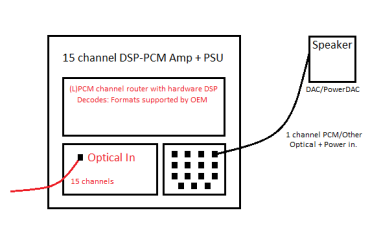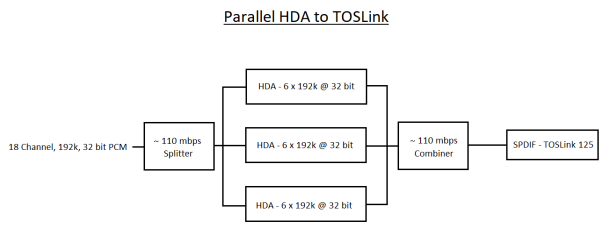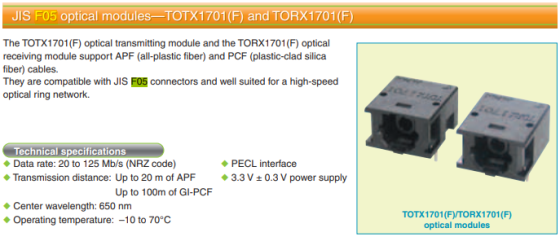DMAS Design [SPDIF-Optical]
Mar 04, 2024


----
Given the current standard IEC 60958-5:2021, the current consumer standard 15 channel SPDIF and 15 channel programmable SPDIF transmitter, a DMAS can be built easily.
GPU's (especially with HDMI 2.0+) can do 1536k total sample aggregates (HDA's max, ~37mbps), which is: 8 x 192k = 1536k | 15 x 96k = 1440k (34.6mbps).
If we stick with the tick box system, and update Windows, we can add the formats needed to SPDIF, although globally (shows on all SPDIF devices).
Unfortunately HDA can't support 15 x 192k, as its too much bitrate and total samples, 15 x 192k = 2880k (~70 mbps).
Windows also needs to support more than 8 channels for PCM output, try and set more than 8 speakers using Windows config.
----


----
The DSP amp can have a set maximum decibel output (for example, full volume = 120dB out), speakers can have a set input, and a larger input can be attenuated (losslessly).
Technically speaking the total audio volume could be used to regulate the total power a single speaker can draw, and the same for output for the DMAS.
You can image the main unit of the DMAS as a PCM processor or SPU (sound processor unit), with-without DTS-Dolby-Other PCM enhancements.
32 bit float should make volume and power management at the PCM level, without amp (no Class-D), doable.
---
Please note that a DMAS does not make DTS-Dolby redundant, instead more into PCM processors at the DSP point (external main unit, not software).
The compressed formats can-are used to bypass channel restrictions (such as Windows, 8 channel) and reduced bandwidth.
Note that while compressed audio formats decode to PCM, they passthrough PCM processors (not in PCM form, inside a container), until decoded.
Since the main unit is working at the input level (PCM), formats can be decoded as normal, then continue to processing as PCM.